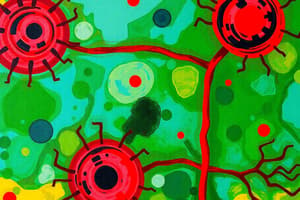Podcast
Questions and Answers
Which of the following is NOT a cause of cell injury?
Which of the following is NOT a cause of cell injury?
- Nutritional deficiencies
- Oxygen deprivation
- Increased physical activity (correct)
- Infectious agents
Mitochondrial dysfunction can lead to ATP depletion.
Mitochondrial dysfunction can lead to ATP depletion.
True (A)
What is the difference between necrosis and apoptosis?
What is the difference between necrosis and apoptosis?
Necrosis is uncontrolled cell death often resulting from injury, while apoptosis is programmed cell death that occurs naturally.
____________ is a genetic defect characterized by an extra copy of chromosome 21.
____________ is a genetic defect characterized by an extra copy of chromosome 21.
Which factor does NOT affect cellular response to injury?
Which factor does NOT affect cellular response to injury?
Match the following types of stimuli with their effects on cells:
Match the following types of stimuli with their effects on cells:
Cell injury can be reversible or irreversible.
Cell injury can be reversible or irreversible.
Name one biochemical mechanism that contributes to cell injury.
Name one biochemical mechanism that contributes to cell injury.
What is the primary action of free radicals in cell injury?
What is the primary action of free radicals in cell injury?
All elements in the universe are composed of the same types of atoms.
All elements in the universe are composed of the same types of atoms.
Name the four most important elements that make up 96% of the human body weight.
Name the four most important elements that make up 96% of the human body weight.
A free radical is an atom or group of atoms having one or more unpaired electrons in the ______.
A free radical is an atom or group of atoms having one or more unpaired electrons in the ______.
Match the following cellular responses to their functions:
Match the following cellular responses to their functions:
Which of the following processes can lead to free radical injury?
Which of the following processes can lead to free radical injury?
Chemical injuries are always due to biologically active substances.
Chemical injuries are always due to biologically active substances.
What is the role of superoxide in cell injury?
What is the role of superoxide in cell injury?
What initiates lipid peroxidation of membranes?
What initiates lipid peroxidation of membranes?
Cross linking of proteins can lead to extensive damage to the cell.
Cross linking of proteins can lead to extensive damage to the cell.
What is cellular swelling also known as?
What is cellular swelling also known as?
Cellular swelling is caused by the shift of extracellular water into the ______.
Cellular swelling is caused by the shift of extracellular water into the ______.
Match the following terms with their descriptions:
Match the following terms with their descriptions:
Which of the following factors can lead to cellular swelling?
Which of the following factors can lead to cellular swelling?
Cellular swelling is a permanent condition.
Cellular swelling is a permanent condition.
What effect do free radicals have on DNA?
What effect do free radicals have on DNA?
Flashcards
Free Radical
Free Radical
A highly reactive atom or molecule with an unpaired electron in its outer shell, making it unstable and eager to react.
Lipid Peroxidation
Lipid Peroxidation
The process of damaging lipids, particularly cell membranes, through the action of free radicals.
Free Radical Injury
Free Radical Injury
A common pathway for various types of cell injury, including chemical and radiation damage, involving the harmful activity of free radicals.
Catalase
Catalase
Signup and view all the flashcards
Superoxide Radical (O2-)
Superoxide Radical (O2-)
Signup and view all the flashcards
Nitric Oxide (NO)
Nitric Oxide (NO)
Signup and view all the flashcards
Cross-linking of Proteins
Cross-linking of Proteins
Signup and view all the flashcards
Indirectly Acting Chemicals
Indirectly Acting Chemicals
Signup and view all the flashcards
Hypoxia
Hypoxia
Signup and view all the flashcards
Reversible Cell Injury
Reversible Cell Injury
Signup and view all the flashcards
Irreversible Cell Injury (Cell Death)
Irreversible Cell Injury (Cell Death)
Signup and view all the flashcards
Necrosis
Necrosis
Signup and view all the flashcards
Apoptosis
Apoptosis
Signup and view all the flashcards
Adaptive Changes
Adaptive Changes
Signup and view all the flashcards
Generation of Reactive Oxygen Species (ROS)
Generation of Reactive Oxygen Species (ROS)
Signup and view all the flashcards
Loss of Calcium Homeostasis
Loss of Calcium Homeostasis
Signup and view all the flashcards
Damage to DNA
Damage to DNA
Signup and view all the flashcards
Antioxidants
Antioxidants
Signup and view all the flashcards
Cellular Swelling
Cellular Swelling
Signup and view all the flashcards
Cellular swelling
Cellular swelling
Signup and view all the flashcards
Causes of cellular swelling
Causes of cellular swelling
Signup and view all the flashcards
Study Notes
Cell Injury and Death
- Cell injury is the initial response of a cell to damaging stimuli.
- The response depends on the type, duration, and severity of the injury.
- Consequences depend on the type of injury, cell status, adaptability, and genetic makeup.
- Cell injury can be reversible or irreversible.
- Reversible injury can potentially return to normal cell function.
- Irreversible injury leads to cell death.
- Cell death can occur through necrosis or apoptosis.
Causes of Cell Injury
- Oxygen deprivation (hypoxia/ischemia)
- Nutrient deficiencies (protein, vitamins, iron, copper)
- Chemical agents
- Infectious agents
- Physical agents
- Immunological reactions (allergies, anaphylaxis, autoimmunity, immunodeficiency)
- Genetic defects (e.g., Down syndrome, sickle cell anemia)
Factors Affecting Cell Injury
- Cellular response to injurious stimuli depends on its type, duration, and severity.
- Consequences of an injurious stimulus depend on the type of injury, the cell's status, its adaptability, and its genetic makeup.
Changes Following Physiological or Pathological Stimuli
- Cell injury (reversible or irreversible)
- Necrosis and apoptosis
- Adaptive changes
General Biochemical Mechanisms
- ATP depletion (oxygen deprivation, hypoxia, ischemia, glucose unavailability, impaired transport)
- Protein synthesis disruption.
- Metabolic pathway disturbances.
- Reactive oxygen species generation (radiation, toxins, chemicals, lipid peroxidation)
Loss of Calcium Homeostasis
- Ischemia or toxins activate phospholipases, proteases, endonucleases, and ATPases.
- Increased cytosolic calcium disrupts cellular function leading to damage.
Mitochondrial Dysfunction
- Mitochondrial dysfunction induced by various stimuli results in a mitochondrial permeability transition (MPT)
- MPT results in proton gradient decay, cytochrome C release, and apoptotic consequences.
Free Radical-Induced Injury
- Free radicals are generated through reduction-oxidation reactions, nitric oxide, absorption of radiant energy (ionizing radiation), and enzymatic metabolism of exogenous chemicals (e.g., CCl4).
- Effects include lipid peroxidation, DNA damage, and protein cross-linking.
- Antioxidant defenses (e.g., vitamin E, glutathione peroxidase) and enzymes play a crucial role in counteracting free radical damage.
Superoxide Dismutase, Glutathione Peroxidase, and Catalase
- Superoxide dismutase converts superoxide radicals to hydrogen peroxide.
- Glutathione peroxidase converts hydrogen peroxide to water.
- Catalase also converts hydrogen peroxide to water.
Chemical Injury
- Some chemicals directly react with critical cellular components or organelles (antibiotics, antineoplastic agents) affecting ion transport and increasing membrane permeability.
- Other chemicals (e.g., CCl4) need metabolic activation to become toxic free radicals.
- These toxins damage membranes by reacting directly with lipids and proteins.
Cellular Swelling
- Cellular swelling (cloudy swelling) is an early reversible response to various injuries.
- The cause is often a shift of extracellular fluid into the cell due to impaired cellular metabolism.
- It is characterized by increased cell size and granular cytoplasm.
Mechanisms of Free Radical Injury
- Lipid peroxidation of membranes by free radicals.
- Damage to proteins due to free radical cross-linking of protein sulfhydryl bonds.
- Damage to DNA due to free radical reaction with DNA components.
Inactivation of Free Radicals
- Involves Endogenous or exogenous antioxidants and enzymes.
Free Radical Cell Injury
- Free radical injury is a final common pathway in various cellular injuries, including chemical and radiation damage, phagocytosis, aging, and cancer.
Elements
- All matter in the universe is composed of basic units known as elements.
- Elements are fundamental substances made of only one type of atoms (e.g., hydrogen, nitrogen, oxygen).
- Carbon, hydrogen, nitrogen, and oxygen are the major elements that make up about 96% of the body.
Atom
- Atoms are composed of protons, neutrons, and electrons.
- The nucleus contains protons and neutrons.
Free Radicals
- Free radicals are atoms or groups of atoms bearing one or more unpaired electrons.
- They are extremely reactive and cause various cellular damages.
- Four major free radicals exist: superoxide, hydrogen peroxide, hydroxyl radicals, singlet oxygen.
Studying That Suits You
Use AI to generate personalized quizzes and flashcards to suit your learning preferences.




